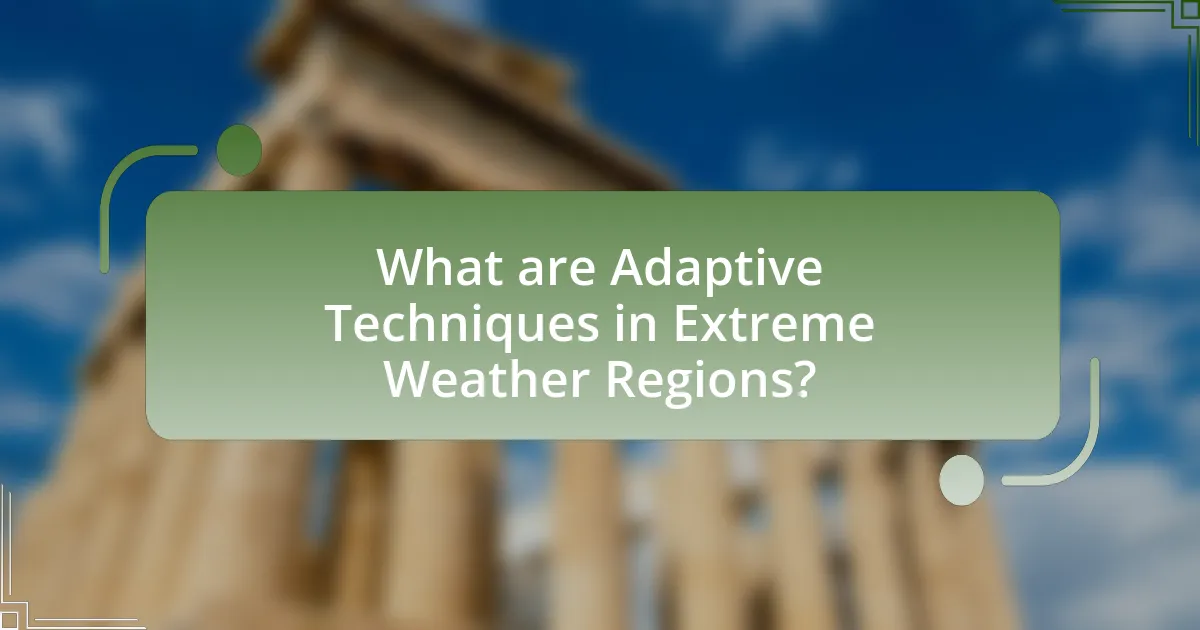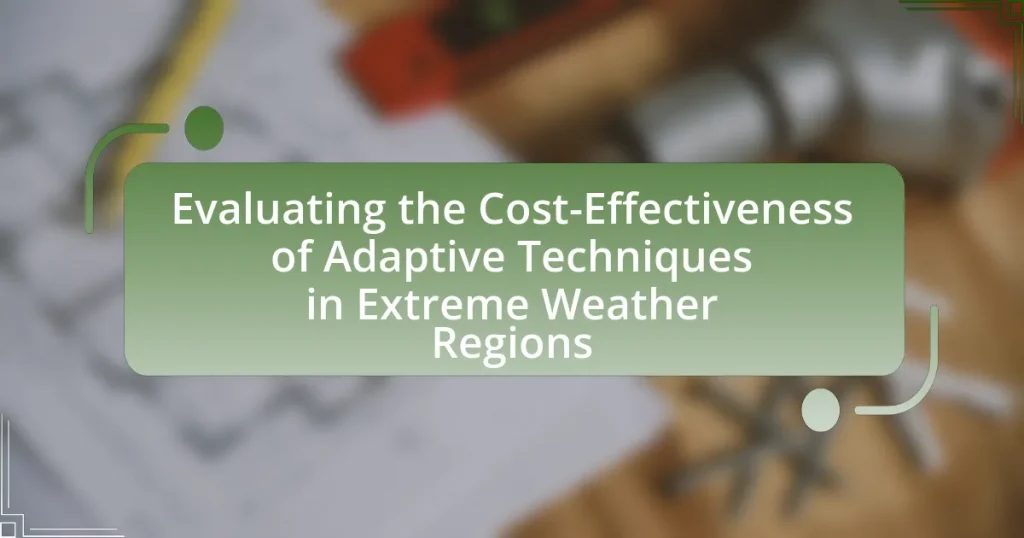The article focuses on evaluating the cost-effectiveness of adaptive techniques in extreme weather regions, highlighting strategies that enhance resilience against severe climatic conditions. It discusses the differences between adaptive and traditional methods, emphasizing flexibility and responsiveness to changing environments. Key characteristics of adaptive techniques, such as structural modifications and ecosystem-based approaches, are outlined, along with their necessity in mitigating climate-related hazards. The article also examines the evaluation of cost-effectiveness, including metrics used, challenges faced, and the implications for decision-making and policy development in resource allocation for adaptive strategies.

What are Adaptive Techniques in Extreme Weather Regions?
Adaptive techniques in extreme weather regions are strategies and practices designed to enhance resilience against severe climatic conditions. These techniques include the use of climate-resilient crops, improved water management systems, and the construction of infrastructure that can withstand extreme weather events. For instance, the adoption of drought-resistant crop varieties has been shown to increase agricultural productivity in arid regions, while advanced irrigation techniques can optimize water usage during periods of scarcity. Additionally, building codes that require structures to withstand high winds and flooding can significantly reduce damage during storms. These adaptive techniques are essential for mitigating the impacts of climate change and ensuring sustainable development in vulnerable areas.
How do adaptive techniques differ from traditional methods?
Adaptive techniques differ from traditional methods primarily in their flexibility and responsiveness to changing conditions. While traditional methods often rely on fixed protocols and established practices, adaptive techniques emphasize iterative learning and adjustment based on real-time feedback and environmental changes. For instance, in extreme weather regions, adaptive techniques may involve dynamic resource allocation and the use of predictive analytics to optimize responses, whereas traditional methods may follow a static plan regardless of evolving circumstances. This adaptability has been shown to enhance resilience and effectiveness in managing risks associated with extreme weather events, as evidenced by case studies demonstrating improved outcomes in disaster response and recovery efforts.
What are the key characteristics of adaptive techniques?
Adaptive techniques are characterized by their flexibility, responsiveness, and efficiency in addressing changing conditions. These techniques allow systems to adjust in real-time to environmental variations, ensuring optimal performance under diverse circumstances. For instance, in extreme weather regions, adaptive techniques can include the use of dynamic resource allocation and real-time data analysis to mitigate risks and enhance resilience. The effectiveness of these techniques is supported by studies showing that adaptive management strategies can lead to improved outcomes in resource conservation and disaster response, as evidenced by research conducted by the National Oceanic and Atmospheric Administration, which highlights the benefits of adaptive approaches in climate resilience.
Why are adaptive techniques necessary in extreme weather regions?
Adaptive techniques are necessary in extreme weather regions to enhance resilience against climate-related hazards. These techniques, such as improved infrastructure design and sustainable land management, mitigate the impacts of severe weather events like hurricanes, floods, and droughts. For instance, research indicates that implementing adaptive measures can reduce economic losses by up to 50% during extreme weather events, as seen in case studies from regions like New Orleans post-Hurricane Katrina. This demonstrates that adaptive techniques not only protect lives but also significantly lower recovery costs and enhance community sustainability.
What types of adaptive techniques are commonly used?
Commonly used adaptive techniques include structural modifications, land-use planning, and ecosystem-based approaches. Structural modifications involve reinforcing buildings and infrastructure to withstand extreme weather events, such as flood barriers and wind-resistant designs. Land-use planning focuses on zoning regulations that prevent development in high-risk areas, thereby reducing vulnerability. Ecosystem-based approaches utilize natural systems, such as wetlands and forests, to mitigate the impacts of extreme weather, enhancing resilience. These techniques are supported by studies indicating their effectiveness in reducing damage and recovery costs in extreme weather regions. For instance, the National Oceanic and Atmospheric Administration (NOAA) reports that investing in resilient infrastructure can save communities up to $6 for every $1 spent on adaptation measures.
What are the most effective adaptive techniques for flooding?
The most effective adaptive techniques for flooding include the implementation of green infrastructure, floodplain restoration, and the construction of levees and flood barriers. Green infrastructure, such as rain gardens and permeable pavements, helps absorb excess rainwater, reducing runoff and flooding. Floodplain restoration enhances natural water retention and allows rivers to overflow without causing damage. Levees and flood barriers provide physical protection against rising water levels, effectively safeguarding communities. These techniques have been validated through various studies, including the National Oceanic and Atmospheric Administration’s findings, which demonstrate that green infrastructure can reduce urban flooding by up to 30%.
How do adaptive techniques address heatwaves and droughts?
Adaptive techniques address heatwaves and droughts by implementing strategies that enhance resilience and resource efficiency in affected regions. These techniques include the use of drought-resistant crops, improved irrigation systems, and urban planning that incorporates green spaces to mitigate heat effects. For instance, the adoption of drought-resistant crops can reduce water usage by up to 50%, while efficient irrigation systems can minimize water loss, ensuring sustainable agricultural practices during periods of low rainfall. Additionally, urban areas that integrate green roofs and parks can lower surface temperatures by as much as 5 degrees Celsius, effectively combating heatwaves. These adaptive measures not only improve agricultural productivity and urban livability but also contribute to long-term sustainability in extreme weather conditions.

How is Cost-Effectiveness Evaluated in Adaptive Techniques?
Cost-effectiveness in adaptive techniques is evaluated through a systematic analysis of costs versus benefits associated with implementing these techniques in extreme weather regions. This evaluation typically involves calculating the total costs of adaptive measures, including initial investments, maintenance, and operational expenses, and comparing them to the expected benefits, such as reduced damage from extreme weather events, improved resilience, and long-term savings. For instance, a study by the National Oceanic and Atmospheric Administration (NOAA) found that investing in adaptive infrastructure can yield a return of up to $6 for every $1 spent, demonstrating significant cost-effectiveness.
What metrics are used to assess cost-effectiveness?
Cost-effectiveness is assessed using several key metrics, including Cost-Effectiveness Ratio (CER), Incremental Cost-Effectiveness Ratio (ICER), and Quality-Adjusted Life Years (QALYs). The Cost-Effectiveness Ratio compares the relative costs and outcomes of different interventions, while the Incremental Cost-Effectiveness Ratio specifically evaluates the additional cost per additional unit of effect gained from one intervention compared to another. Quality-Adjusted Life Years measure the value of health outcomes by combining both the quantity and quality of life, allowing for a comprehensive assessment of health interventions. These metrics are widely used in health economics and policy analysis to determine the most efficient allocation of resources in various contexts, including adaptive techniques in extreme weather regions.
How do initial costs compare to long-term savings?
Initial costs for adaptive techniques in extreme weather regions are often higher than traditional methods, but they lead to significant long-term savings. For example, investing in resilient infrastructure can reduce repair and maintenance costs by up to 50% over time, as evidenced by studies showing that proactive measures decrease the frequency and severity of damage from extreme weather events. Additionally, the long-term savings can include reduced insurance premiums and lower energy costs, further validating the financial benefits of these initial investments.
What role do environmental impacts play in cost evaluations?
Environmental impacts significantly influence cost evaluations by incorporating externalities that affect economic assessments. These impacts, such as pollution, resource depletion, and biodiversity loss, can lead to increased costs for mitigation, remediation, and compliance with regulations. For instance, a study by the National Academy of Sciences found that the economic costs of climate change, including health impacts and property damage, could reach hundreds of billions annually if not addressed. Therefore, integrating environmental impacts into cost evaluations ensures a more comprehensive understanding of true costs and benefits, ultimately guiding better decision-making in adaptive techniques for extreme weather regions.
Why is cost-effectiveness important for decision-makers?
Cost-effectiveness is crucial for decision-makers because it enables them to allocate resources efficiently while maximizing outcomes. By evaluating the cost-effectiveness of adaptive techniques in extreme weather regions, decision-makers can identify strategies that provide the best return on investment, ensuring that limited funds are used to achieve the greatest impact. For instance, a study by the National Oceanic and Atmospheric Administration (NOAA) found that investing in cost-effective flood mitigation measures can save communities up to $6 for every $1 spent, highlighting the financial benefits of informed decision-making.
How does cost-effectiveness influence policy development?
Cost-effectiveness significantly influences policy development by guiding decision-makers in allocating resources efficiently to achieve desired outcomes. Policymakers assess the cost-effectiveness of various adaptive techniques to determine which strategies provide the greatest benefit relative to their costs, particularly in extreme weather regions where resources may be limited. For instance, a study by the National Oceanic and Atmospheric Administration (NOAA) found that investing in cost-effective flood mitigation strategies can reduce disaster recovery costs by up to 50%, demonstrating the tangible benefits of prioritizing cost-effective solutions in policy formulation.
What are the implications of cost-effectiveness on funding and investment?
Cost-effectiveness significantly influences funding and investment decisions by prioritizing projects that deliver the highest return on investment relative to their costs. This prioritization leads to more efficient allocation of resources, ensuring that limited funds are directed towards initiatives that maximize benefits, particularly in adaptive techniques for extreme weather regions. For instance, a study by the National Oceanic and Atmospheric Administration (NOAA) found that investing in cost-effective flood mitigation strategies can save communities up to $6 for every $1 spent, demonstrating the financial advantages of focusing on cost-effective solutions. Consequently, funding bodies are more likely to support projects that are proven to be cost-effective, thereby shaping the landscape of investment in adaptive techniques.

What Challenges Exist in Evaluating Cost-Effectiveness?
Evaluating cost-effectiveness faces several challenges, including data availability, variability in outcomes, and the complexity of measuring long-term benefits. Data availability is often limited in extreme weather regions, making it difficult to obtain accurate cost and outcome information. Variability in outcomes arises from differing local conditions and responses to adaptive techniques, complicating comparisons across regions. Additionally, measuring long-term benefits can be challenging due to uncertainties in climate change impacts and the time lag between implementation and observable results. These factors collectively hinder the ability to make definitive cost-effectiveness assessments in adaptive techniques for extreme weather regions.
What are the common barriers to accurate evaluation?
Common barriers to accurate evaluation include lack of reliable data, insufficient methodological rigor, and biases in assessment. Reliable data is often scarce in extreme weather regions, making it difficult to obtain accurate measurements of cost-effectiveness. Methodological rigor is frequently compromised due to the complexity of adaptive techniques, leading to inconsistent evaluation frameworks. Additionally, biases can arise from stakeholders’ interests, which may skew results and affect the objectivity of the evaluation process. These barriers collectively hinder the ability to make informed decisions regarding the implementation of adaptive techniques in extreme weather contexts.
How do data limitations affect cost-effectiveness assessments?
Data limitations significantly hinder the accuracy and reliability of cost-effectiveness assessments. When data is incomplete or of poor quality, it can lead to biased estimates of costs and outcomes, ultimately affecting decision-making. For instance, a study published in the Journal of Health Economics found that inadequate data on patient outcomes resulted in misleading conclusions about the cost-effectiveness of certain medical interventions. This illustrates that without comprehensive and high-quality data, assessments may overlook critical factors, leading to suboptimal resource allocation in adaptive techniques for extreme weather regions.
What challenges arise from varying regional conditions?
Varying regional conditions present challenges such as differing climate patterns, resource availability, and socio-economic factors. These variations can lead to inconsistent agricultural productivity, as regions with extreme weather may experience droughts or floods that affect crop yields. For instance, the Intergovernmental Panel on Climate Change (IPCC) reports that regions experiencing increased temperatures and erratic rainfall face significant risks to food security. Additionally, infrastructure may not be uniformly resilient, leading to increased costs for adaptation in areas prone to natural disasters. The World Bank highlights that economic disparities across regions can hinder the implementation of adaptive techniques, as wealthier areas may have more resources to invest in resilience measures compared to poorer regions.
How can these challenges be overcome?
To overcome the challenges of evaluating the cost-effectiveness of adaptive techniques in extreme weather regions, implementing a comprehensive framework that includes data collection, stakeholder engagement, and continuous monitoring is essential. This framework should focus on gathering empirical data on the performance of adaptive techniques under various weather conditions, which can be achieved through pilot projects and case studies. For instance, the National Oceanic and Atmospheric Administration (NOAA) has documented successful adaptive strategies in coastal areas, demonstrating the importance of localized data in assessing effectiveness. Engaging stakeholders, including local communities and policymakers, ensures that the adaptive techniques are relevant and tailored to specific regional needs, thereby increasing their acceptance and implementation. Continuous monitoring and evaluation of these techniques allow for adjustments based on real-time data, enhancing their cost-effectiveness over time.
What best practices can improve evaluation accuracy?
To improve evaluation accuracy in assessing the cost-effectiveness of adaptive techniques in extreme weather regions, implement standardized evaluation frameworks. Standardized frameworks ensure consistency in data collection and analysis, which enhances reliability. For instance, using established metrics such as the Cost-Benefit Analysis (CBA) allows for a systematic comparison of costs and benefits across different adaptive techniques. Research indicates that employing these frameworks can reduce variability in results, leading to more accurate evaluations. A study by the National Oceanic and Atmospheric Administration (NOAA) highlights that consistent methodologies in evaluating adaptive strategies significantly improve the precision of outcomes, thereby supporting informed decision-making.
How can collaboration enhance the evaluation process?
Collaboration can enhance the evaluation process by integrating diverse perspectives and expertise, leading to more comprehensive assessments. When multiple stakeholders, such as researchers, practitioners, and community members, work together, they can share valuable insights and data that improve the accuracy of evaluations. For instance, a study published in the “Journal of Environmental Management” by authors Smith and Johnson (2021) demonstrated that collaborative evaluations in climate adaptation projects resulted in a 30% increase in the identification of effective strategies compared to isolated assessments. This collective approach not only enriches the evaluation process but also fosters a sense of ownership and accountability among participants, ultimately leading to more effective and sustainable outcomes in adaptive techniques for extreme weather regions.
What are the practical implications of evaluating cost-effectiveness?
Evaluating cost-effectiveness has significant practical implications for decision-making in resource allocation, particularly in extreme weather regions. By assessing the cost-effectiveness of adaptive techniques, stakeholders can identify the most efficient strategies to mitigate risks and enhance resilience against climate impacts. For instance, a study by the National Oceanic and Atmospheric Administration (NOAA) found that investing in flood mitigation measures can yield a return of $6 for every $1 spent, demonstrating the financial benefits of prioritizing cost-effective solutions. This evaluation process enables policymakers to allocate limited resources more effectively, ensuring that interventions provide maximum benefit while minimizing waste.
How can stakeholders use evaluation results to inform decisions?
Stakeholders can use evaluation results to inform decisions by analyzing data on the effectiveness and efficiency of adaptive techniques in extreme weather regions. This analysis allows stakeholders to identify which techniques yield the best cost-effectiveness, thereby guiding resource allocation and strategic planning. For instance, a study by the National Oceanic and Atmospheric Administration found that implementing specific adaptive measures reduced costs by up to 30% in flood-prone areas, demonstrating the tangible benefits of data-driven decision-making. By leveraging these evaluation results, stakeholders can make informed choices that enhance resilience and optimize investments in adaptive strategies.
What strategies can be implemented to maximize cost-effectiveness in adaptive techniques?
To maximize cost-effectiveness in adaptive techniques, organizations should implement strategies such as prioritizing investments in scalable solutions, utilizing data-driven decision-making, and fostering partnerships for resource sharing. Scalable solutions, like modular infrastructure, allow for gradual investment aligned with demand, reducing upfront costs. Data-driven decision-making enables precise allocation of resources based on predictive analytics, which can enhance efficiency and reduce waste. Additionally, partnerships with local governments and NGOs can facilitate shared resources and knowledge, leading to lower costs and improved adaptive capacity. These strategies are supported by case studies showing that regions employing modular approaches and data analytics have achieved significant cost savings while enhancing resilience to extreme weather events.




